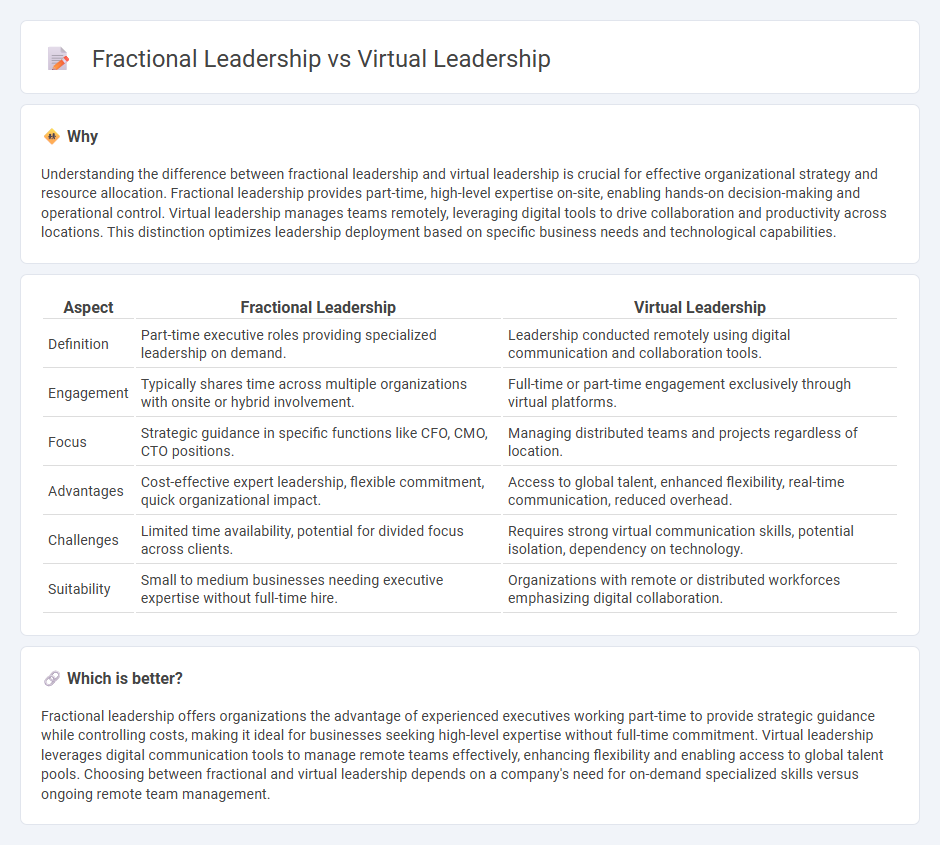
Fractional leadership involves hiring experienced executives on a part-time basis to provide strategic guidance and operational oversight, optimizing costs while leveraging high-level expertise. Virtual leadership, on the other hand, focuses on managing remote teams and projects through digital communication tools, emphasizing flexibility and collaboration across dispersed locations. Explore further to understand which leadership model best suits your organization's evolving needs.
Why it is important
Understanding the difference between fractional leadership and virtual leadership is crucial for effective organizational strategy and resource allocation. Fractional leadership provides part-time, high-level expertise on-site, enabling hands-on decision-making and operational control. Virtual leadership manages teams remotely, leveraging digital tools to drive collaboration and productivity across locations. This distinction optimizes leadership deployment based on specific business needs and technological capabilities.
Comparison Table
| Aspect | Fractional Leadership | Virtual Leadership |
|---|---|---|
| Definition | Part-time executive roles providing specialized leadership on demand. | Leadership conducted remotely using digital communication and collaboration tools. |
| Engagement | Typically shares time across multiple organizations with onsite or hybrid involvement. | Full-time or part-time engagement exclusively through virtual platforms. |
| Focus | Strategic guidance in specific functions like CFO, CMO, CTO positions. | Managing distributed teams and projects regardless of location. |
| Advantages | Cost-effective expert leadership, flexible commitment, quick organizational impact. | Access to global talent, enhanced flexibility, real-time communication, reduced overhead. |
| Challenges | Limited time availability, potential for divided focus across clients. | Requires strong virtual communication skills, potential isolation, dependency on technology. |
| Suitability | Small to medium businesses needing executive expertise without full-time hire. | Organizations with remote or distributed workforces emphasizing digital collaboration. |
Which is better?
Fractional leadership offers organizations the advantage of experienced executives working part-time to provide strategic guidance while controlling costs, making it ideal for businesses seeking high-level expertise without full-time commitment. Virtual leadership leverages digital communication tools to manage remote teams effectively, enhancing flexibility and enabling access to global talent pools. Choosing between fractional and virtual leadership depends on a company's need for on-demand specialized skills versus ongoing remote team management.
Connection
Fractional leadership and virtual leadership intersect through their focus on flexible, decentralized management frameworks that leverage technology to guide organizations remotely. Fractional leaders provide specialized expertise on a part-time basis, often via virtual platforms, enabling companies to access strategic leadership without full-time commitments. This synergy maximizes operational efficiency and agility by integrating remote executive presence with scalable leadership resources.
Key Terms
Remote Communication
Virtual leadership emphasizes managing distributed teams through robust digital communication tools, ensuring effective collaboration across time zones. Fractional leadership involves part-time executive roles providing strategic guidance and decision-making remotely, often integrating into existing leadership structures. Explore detailed strategies for optimizing remote communication in both virtual and fractional leadership models.
Part-Time Engagement
Virtual leadership thrives on managing remote teams with digital tools, fostering communication and productivity regardless of location. Fractional leadership involves part-time engagement where experienced executives provide strategic guidance without full-time commitment, optimizing resources for small to mid-sized businesses. Explore how part-time fractional leadership can enhance your organization's agility and expertise.
Accountability
Virtual leadership emphasizes accountability through clear communication, goal alignment, and performance tracking in remote team settings, ensuring team members stay responsible despite physical distances. Fractional leadership provides part-time executives who bring targeted accountability by focusing on strategic priorities and measurable outcomes within limited engagements. Explore how these leadership models enhance accountability and drive business results effectively.
Source and External Links
What is virtual leadership? (And how to manage remote teams) - Virtual leadership involves managing teams remotely, using technology to communicate and motivate team members across different locations or time zones.
Virtual Leadership: The challenges and strategies to overcome them - This guide discusses the challenges and strategies for virtual leaders, including fostering trust and managing team dynamics through digital communication tools.
Virtual Leadership and How to Properly Lead a Remote Team - This resource emphasizes the importance of virtual leadership in managing remote teams effectively, focusing on communication and trust-building across different locations.
 dowidth.com
dowidth.com